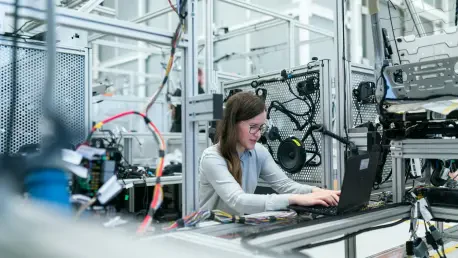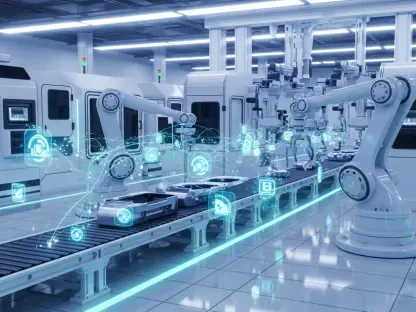In an era where industrial production faces unprecedented demands for efficiency and adaptability, a transformative partnership between two titans of technology and manufacturing has emerged to redefine the landscape. Siemens and Trumpf have joined forces to tackle the persistent challenges of integrating information technology (IT) with operational technology (OT), a divide that has long stifled innovation on factory floors worldwide. This collaboration promises to usher in a new wave of digital manufacturing solutions, leveraging advanced tools and AI readiness to enhance productivity. By merging Siemens’ robust digital platforms with Trumpf’s specialized expertise in machine tools and lasers, the alliance aims to create a seamless, scalable framework that empowers manufacturers to thrive in an increasingly competitive environment. The implications of this partnership extend far beyond immediate operational gains, signaling a broader shift toward smarter, more connected industrial ecosystems.
Pioneering Digital Integration in Manufacturing
Bridging the IT-OT Gap for Seamless Operations
The core of this groundbreaking collaboration lies in its mission to bridge the historical disconnect between IT and OT systems, a barrier that has often led to inefficiencies in industrial settings. Siemens and Trumpf are combining their strengths to develop integrated solutions that enable smooth data flow between enterprise systems and shop floor machinery. This connectivity is vital for real-time adaptability, allowing manufacturers to respond swiftly to changing production conditions. Siemens’ Xcelerator portfolio, a comprehensive suite of digital tools, works in tandem with Trumpf’s proficiency in manufacturing software to create a unified digital backbone. This framework ensures that data from machines can be accessed and analyzed instantly, fostering faster decision-making. The emphasis on seamless integration highlights a critical industry need: to eliminate silos and create cohesive systems that drive operational excellence across diverse manufacturing environments.
Fostering Real-Time Decision-Making with Connectivity
Beyond simply connecting systems, the partnership focuses on empowering manufacturers with the ability to make informed decisions in real time, a game-changer for modern production lines. By prioritizing open and interoperable IT interfaces, Siemens and Trumpf ensure that data from various sources—whether from robotics or laser systems—can be aggregated and utilized effectively. This level of connectivity, as emphasized by industry leaders from both companies, is the foundation for transforming factories into agile, responsive hubs. The ability to monitor and adjust processes on the fly reduces downtime and enhances overall efficiency, addressing long-standing pain points in industrial workflows. Moreover, this approach lays the groundwork for future innovations, ensuring that manufacturers are not just reacting to current demands but are also prepared for emerging challenges. The result is a more dynamic production environment where technology serves as a catalyst for continuous improvement.
Driving Innovation Through AI and Scalability
Preparing Industries for AI-Driven Automation
A pivotal aspect of the Siemens-Trumpf alliance is its forward-thinking commitment to AI readiness, particularly in applications like motion control that are central to modern manufacturing. By embedding AI capabilities into their joint solutions, the partnership enables manufacturers to optimize production processes with unprecedented precision and flexibility. This focus on artificial intelligence addresses the growing need for data-driven insights, allowing systems to predict maintenance needs, adjust workflows, and improve output quality autonomously. The integration of AI not only boosts efficiency but also positions industries to stay ahead in a rapidly evolving technological landscape. As digital transformation becomes a cornerstone of competitive advantage, this initiative ensures that manufacturers of all sizes can harness cutting-edge tools to meet market demands without being constrained by outdated systems or fragmented data.
Scaling Solutions with Modular and Open Systems
Equally significant is the emphasis on scalability through modular system architectures and standardized interfaces, a strategy designed to reduce engineering costs and accelerate innovation cycles. Siemens and Trumpf are committed to creating open automation systems that allow for easy integration of hardware and software, catering to the diverse needs of manufacturers. This modularity ensures that solutions can be tailored to specific operations while remaining flexible enough to evolve with technological advancements. The reduction in operational bottlenecks and faster time-to-market are tangible benefits that enhance competitiveness, particularly for small and medium-sized enterprises. By fostering an ecosystem of interoperable tools, the partnership tackles the complexity of modern production, making it easier for companies to adopt new technologies without overhauling existing infrastructure. This scalable approach is a testament to the vision of creating lasting value through adaptable, efficient systems.
Reflecting on a Milestone in Industrial Evolution
Laying the Foundation for Future Factories
Looking back, the collaboration between Siemens and Trumpf stood as a defining moment in the journey toward smarter industrial production. Their combined efforts successfully addressed the critical IT-OT divide, delivering solutions that enhanced connectivity and operational efficiency. The integration of Siemens’ digital platforms with Trumpf’s manufacturing expertise resulted in a powerful synergy, one that redefined how factories operated by prioritizing real-time data and seamless workflows. This partnership not only resolved immediate inefficiencies but also built a robust foundation for long-term advancements, ensuring that industries were better equipped to handle evolving challenges. The focus on open standards and collaborative ecosystems became a benchmark for how technology could transform manufacturing landscapes.
Envisioning Next Steps for Digital Transformation
As the impact of this alliance unfolded, it became clear that the next steps involved a deeper embrace of AI and scalable systems to sustain momentum in industrial innovation. Manufacturers were encouraged to adopt these integrated solutions to maintain a competitive edge, focusing on continuous improvement through data-driven strategies. The legacy of standardized interfaces and modular designs offered a clear path forward, urging industries to invest in interoperable technologies that could adapt to future demands. This collaboration served as a reminder that collective expertise and shared vision were essential in overcoming complex challenges, inspiring other industry leaders to pursue similar partnerships. The groundwork laid by Siemens and Trumpf paved the way for a future where factories were not just connected but truly intelligent, capable of driving progress through sustained technological integration.









